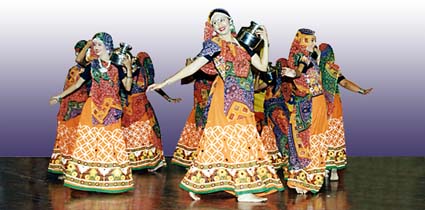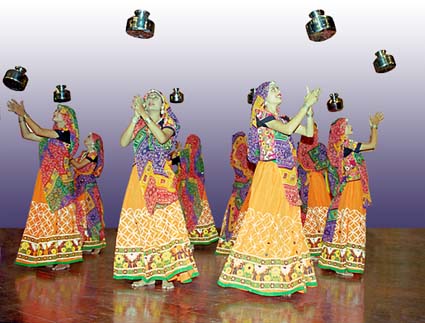Learning Folk Dances
This page describes how students are trained in folk dances at Rangashree, which includes classes and performing.
Folk dances are found throughout India, where they are an important part of life. There are folk dances for religious festivals, vocational celebrations, social events, and entertainment. In the U.S., people of Indian descent maintain their traditions of holding folk dances at weddings and festivals. There are also many folk dance competitions during the year, put on by various Indian associations. With all this activity, Indian folk dances are quite alive in the U.S.
Learning Indian folk dances brings many opportunities. Most obvious is the opportunity to perform. But there's also the chance to be part of a team or performing group, and the satisfaction of achieving a shared purpose. Or if you're a competetive type, it's an opportunity to join dance contests. Folk dances let you learn more about India's diverse traditions. And if you're artistically inclined, folk dances give you opportunities for creative expression through choreography. Whatever your interest, read on to find out how Rangashree can offer you a first hand experience of Indian folk dances.

Classes
Rangashree teaches folk dances of India to all levels of Bharatanatyam students for several reasons.
- Folk dances provide more opportunities to perform on stage, which develops the students as performers.
- They allow beginners to perform before they are ready to perform Bharatanatyam.
- They develop coordination and teamwork, as all folk dances are group dances.
- They encourage students to be more involved in Indian festivals and social occasions.
- Folk dances are fun!
Although folk dances are currently taught as a supplement to Bharatanatyam training, there are plans to add some class sessions dedicated to folk dance, depending on interest. It's not necessary to learn classical dance to become a good folk dancer. So, for those whose only interest is folk dance, dedicated classes make sense. Look for updates on our Dance Class Information page, or contact us if you're interested.
Most people dancing at Indian celebrations didn't learn the folk dances in classes. Indian folk dances have basic steps and movements that are easy to pick up. Youngsters learn by following others. As they get more practice, they add more complex steps and elegant movements, again learnt by imitation. Growing up in a community where folk dances are a part of various social events, this progression happens naturally. Experienced dancers develop an instinctive feel for the dance, and are graceful to watch.
The learning curve is quite different when folk dances are taught in classes. From the beginning, the goal is to perform the dances on stage. Choreographed movements are taught from the start, and the emphasis is on coordinating with a group of dancers.
The training for folk dances isn't as rigorous as for Bharatanatyam. Novices don't need to spend the initial stages practicing basic movements, as building blocks for subsequent advanced elements of the dance. Instead, they start by learning the choreography directly. Beginners start with simpler choreography, and move on to more complex dances as they build experience. Even the simple items are suitable for performing on stage. This lets beginners get a taste of performing, which wouldn't happen until much later if they were learning only Bharatanatyam.
Developing a feel for the music is an important part of being a good folk dancer. Fortunately, most of the music is upbeat and easy to enjoy, even if you don't understand the language. The "feel" that needs to be developed is for the spirit of the dance, that is, the response the dance elicits in dancers from the community where the dance originated. For this, it helps to know a little about the background of the dance, the region of its origin, and the lyrics of the song. A teacher can provide this knowledge, and tune your style so that you dance like someone who grew up with it.
An advantage of folk dance classes is that dances from all over India can be experienced. Rangashree has a repertoire of numerous regional dances, including some tribal dances, that students learn. The variety adds to the fun of the folk dances.
Coming full circle, students who discover folk dances through classes, and enjoy them, may begin to participate more in Indian events that include folk dances.

Performing
One of the great qualities of Indian folk dances is that it's easy to start performing them, yet there is plenty of depth, giving experts room to explore their creativity. As a beginning student, folk dance performances introduce you to the stage without the pressure of a solo performance. As you progress, the experience of dancing in a coordinated group is beneficial. When you become an expert, folk dances allow you to be creative, expressive, and innovative in performing and choreographing dances.
The many opportunities for performing Indian folk dances come in two forms - dance competitions and recitals. Rangashree's folk dancers and students take part in both. Let's look at how Rangashree approaches them differently.
Competitions
Folk dance competitions are popular in India as well as the U.S., and are often associated with festival celebrations. Most are organized by university groups and private associations connected with the Indian community. They are well attended, in terms of competitors as well as audience size.
The competetive nature of the events influences the dances, since the choreography is designed to impress judges and win the contest. It frequently produces brilliant items, but most of them tend to be flashier and faster paced than the traditional versions of the dances. Rangashree's groups tend to stay close to traditional performances, but often distinguish themselves by performing rarely seen dances. It's not an intentional strategy, just the outcome of having a large repertoire of traditional dances from which to draw.
Recitals
Folk dance recitals take place at Indian temples on festival occasions, at multi-cultural or multi-ethnic programs, and within shows that combine classical and folk dance items for variety. Recitals offer more freedom in choreography than competitions. The goal isn't to win, and to stay within the contest rules for a particular category, but to express a theme. The idea could be to use innovative choreography to extend the traditional dance form into something new. Or it could be to present an authentic performance of a traditional dance. Whatever the intention, the freedom of expression is a key feature of recitals.
Rangashree has two main interests in folk dance recitals. One is to explore the artistic creativity afforded by folk dance performances at recitals. The other is to maintain and present authentic performances, true to the spirit of the dance traditions of India. These goals may sound contradictory at first, but they aren't, because traditions survive best when they are kept alive and active. This requires us to be creative while staying true to traditions. It's not easy, but can be done if the art is approached with sincerity.
§
Rangashree is considering forming a folk dance section, to include a dedicated performing group (or groups). Look for updates on our Dance Class Information page, or contact us if you're interested.

⇐ Previous: Bharatanatyam ⇑ Top of Page ⇑ Next: Student's Info ⇒
